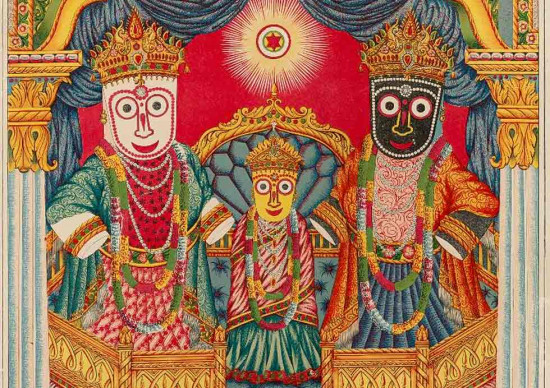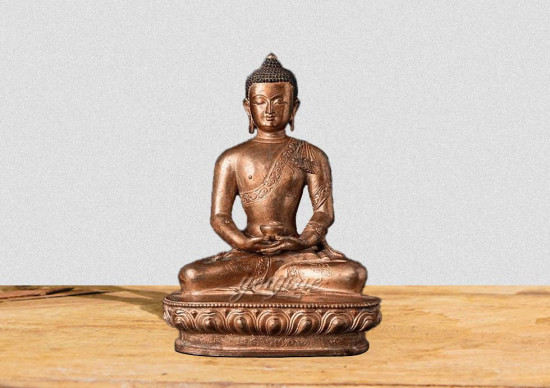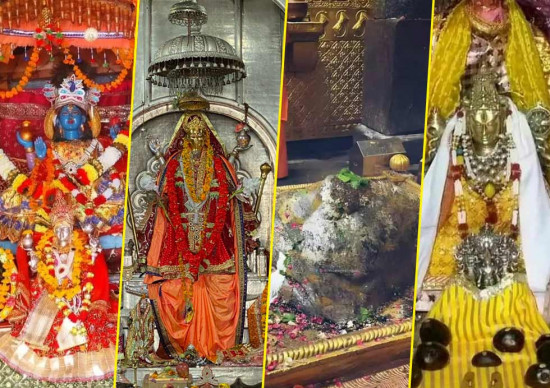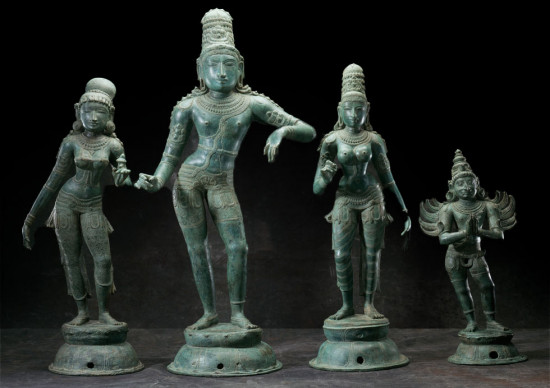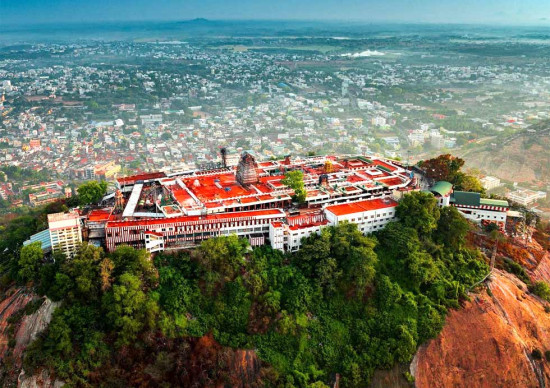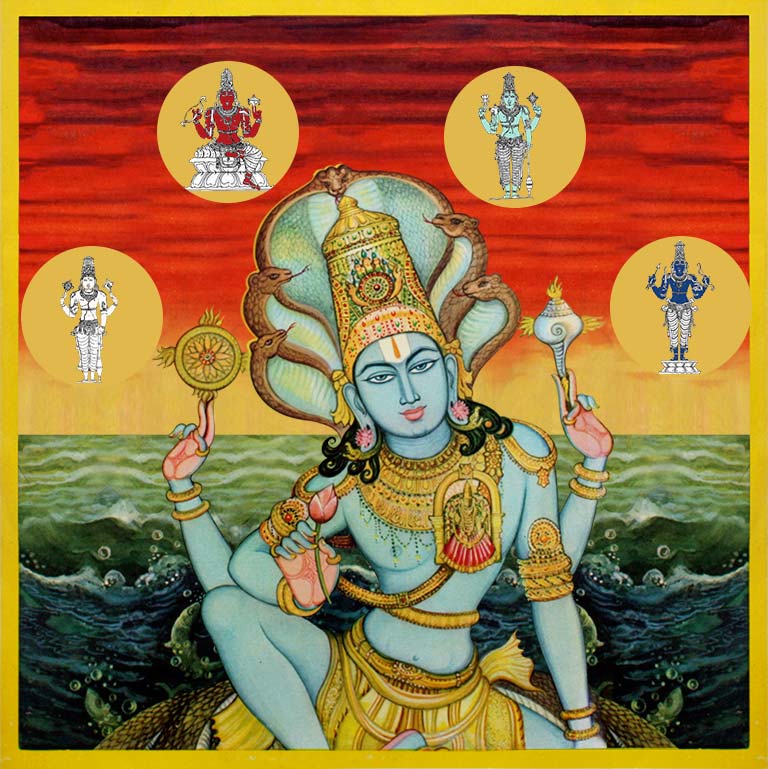
Vishnu is One who becomes Vishvam (perceptible and imperceptible Cosmos) and pervades it therefore, as concluded from the first two names in Vishnu Sahasranama (a chant of thousand names of Vishnu).
The theme of this article is the four emanations of Vishnu (Chatur Vyuham) and their iconography.
A brief on the five classifications of Vishnu’s manifestations is first required, one of which is the Chatur Vyuham.
These manifestations get from subtle to gross progressively but only in terms of descent and proximity to beings. The supreme nature of Vishnu however remains unaltered.
The theme of this article is the four emanations of Vishnu (Chatur Vyuham) and their iconography.
A brief on the five classifications of Vishnu’s manifestations is first required, one of which is the Chatur Vyuham.
These manifestations get from subtle to gross progressively but only in terms of descent and proximity to beings. The supreme nature of Vishnu however remains unaltered.
Para Vasudeva
The highest Brahman realized is Para Vasudeva. This Supreme form of his being is incomparably pure, container of all forms and also formlessness, beyond imagination.
His potential is Lakshmi. The union of the two is absolute, eternal like that of power with the powerful.
Exercising his potential Para Vasudeva differentiates into Vyuha Vasudeva.
His potential is Lakshmi. The union of the two is absolute, eternal like that of power with the powerful.
Exercising his potential Para Vasudeva differentiates into Vyuha Vasudeva.
Vyuha Vasudeva
Vyuha Vasudeva
Vyuha Vasudeva is a composite causing three other forms. The four forms collectively are called Chatur Vyuham.
- From Vyuha Vasudev originates Sankarshana
- From Sankarshana proceeds Pradyumna
- From Pradyumna emanates Aniruddha
The four forms together in the Chatur Vyuham are same as Para Vasudeva mentioned above.
- From Vyuha Vasudev originates Sankarshana
- From Sankarshana proceeds Pradyumna
- From Pradyumna emanates Aniruddha
The four forms together in the Chatur Vyuham are same as Para Vasudeva mentioned above.
Vibhava
Vishnu assumes Avatara (incarnation) time and again, endlessly to deliver the righteous and punish the wicked as declared by Vishnu himself in Bhagwad Geeta.
All Avataras of his such as Matsya, Kurma, Varaha, Narasimha etc. proceed from the last emanation of Chatur Vyuham – Aniruddha.
The Avatara manifestation of Vishnu is called Vibhava.
All Avataras of his such as Matsya, Kurma, Varaha, Narasimha etc. proceed from the last emanation of Chatur Vyuham – Aniruddha.
The Avatara manifestation of Vishnu is called Vibhava.
Sukshma Vasudeva
The Supreme pervades the Cosmos on elemental level as Vishnu and beings on an inner level as Antaryamin (the inner controller and witness).
Shastra explains that Vishnu is present in an infinitesimally small space in the heart of every being. A handsome two-armed form, dressed in yellow robes.
This is the fourth classification of Vishnu’s manifestations. It is united with the Jiva (being) eternally and closest to him though imperceptible.
He accompanies the Jiva birth after birth as silent, unattached witness to his Karma (actions) and their fruits. He is the one Jiva realizes as Para Vasudeva in Vaikuntham after release.
Shastra explains that Vishnu is present in an infinitesimally small space in the heart of every being. A handsome two-armed form, dressed in yellow robes.
This is the fourth classification of Vishnu’s manifestations. It is united with the Jiva (being) eternally and closest to him though imperceptible.
He accompanies the Jiva birth after birth as silent, unattached witness to his Karma (actions) and their fruits. He is the one Jiva realizes as Para Vasudeva in Vaikuntham after release.
Archa
Since the Jiva cannot perceive Vishnu in any of his Para, Vyuha or Vibhava manifestations, He, the ever compassionate chooses to reside in idols consecrated and installed as per Agamic rituals in temples and even home-altars of his devotes.
This is his Archa manifestation where he becomes perceptible and physically accessible to Jiva
The Archa form is not to be looked on as an idol but one of the five manifestations of Vishnu, complete in all his glory, capable of responding to the Jiva.
This is his Archa manifestation where he becomes perceptible and physically accessible to Jiva
The Archa form is not to be looked on as an idol but one of the five manifestations of Vishnu, complete in all his glory, capable of responding to the Jiva.
Iconography of Chatur Vyuham
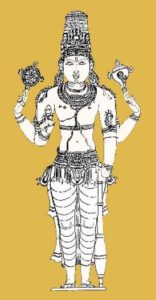
Vyuha Vasudeva Murti
He is described and represented variously as bright, clear like pure crystal, as cow’s milk, jasmine or fresh snow.
Peaceful and benevolent, he adorns yellow or red garments. May be shown as two or four armed.
As four armed his lower right hand is in the gesture of protection or holds a lotus. A mace in the lower left.
His upper right hand holds Sudarshan Chakra (discus) and upper left Panchajanya Shankha (conch).
His being is adorned in rich ornaments.
He is described and represented variously as bright, clear like pure crystal, as cow’s milk, jasmine or fresh snow.
Peaceful and benevolent, he adorns yellow or red garments. May be shown as two or four armed.
As four armed his lower right hand is in the gesture of protection or holds a lotus. A mace in the lower left.
His upper right hand holds Sudarshan Chakra (discus) and upper left Panchajanya Shankha (conch).
His being is adorned in rich ornaments.
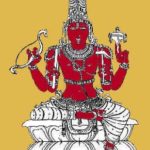
Vyuha Sankarshana Murti
Lustrous and glowing, his hue is red as that of a ruby or the morning sun. He is depicted as very strong and vigorous.
He wears yellow or blue garments; an earring in one ear.
In his lower set of hands he holds Musala (pestle) and a Hala (plough) while in the upper he bears Sharanga Dhanush (bow) and Panchajanya Shankha.
Lustrous and glowing, his hue is red as that of a ruby or the morning sun. He is depicted as very strong and vigorous.
He wears yellow or blue garments; an earring in one ear.
In his lower set of hands he holds Musala (pestle) and a Hala (plough) while in the upper he bears Sharanga Dhanush (bow) and Panchajanya Shankha.
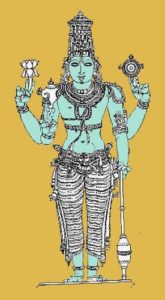
Vyuha Sankarshana Murti
Pradyumna is the hue of tender Durva (kind of grass), greenish blue and lustrous like the glow of a blue gem.Laden with unsurpassable handsomeness, he appears a trifle intoxicated.
He wears yellow or red garments, his being beautified with rich, delicate ornaments.
In his lower hands he holds Panchajanya Shankha and Kaumodaki Gada (mace). His upper set of hands are adorned with Padma (lotus) and Sudarshan Chakra.
When two armed he is shown holding Sharanga Dhanush and an arrow, wearing white garments.
Pradyumna is the hue of tender Durva (kind of grass), greenish blue and lustrous like the glow of a blue gem.Laden with unsurpassable handsomeness, he appears a trifle intoxicated.
He wears yellow or red garments, his being beautified with rich, delicate ornaments.
In his lower hands he holds Panchajanya Shankha and Kaumodaki Gada (mace). His upper set of hands are adorned with Padma (lotus) and Sudarshan Chakra.
When two armed he is shown holding Sharanga Dhanush and an arrow, wearing white garments.
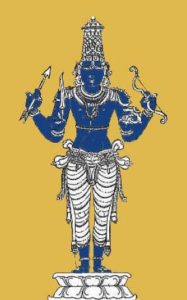
Vyuha Aniruddha Murti
Dark-blue like a rain bearing cloud, he inherits Pradyumna’s handsomeness from whom he emanates.
He wears Pitambara (yellow silken garments). He is also described as rather pinkish like a fresh lotus, wearing red garments.
He adorns rich ornaments and Vanamala (long wild-flower garland).
In his lower set of hands he holds Khadga (dagger) and Khetaka (shield). In the upper hands he bears Sharanga Dhanush and an arrow.
He is also depicted in a recumbent position, resting on Adi Sesha (serpent serving as Vishnu’s couch) with his consorts.
He wears Pitambara (yellow silken garments). He is also described as rather pinkish like a fresh lotus, wearing red garments.
He adorns rich ornaments and Vanamala (long wild-flower garland).
In his lower set of hands he holds Khadga (dagger) and Khetaka (shield). In the upper hands he bears Sharanga Dhanush and an arrow.
He is also depicted in a recumbent position, resting on Adi Sesha (serpent serving as Vishnu’s couch) with his consorts.

